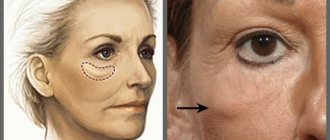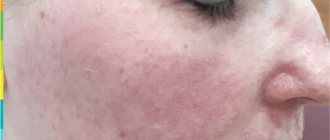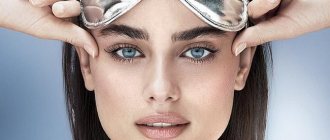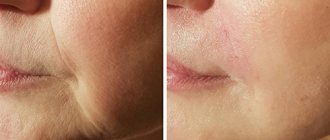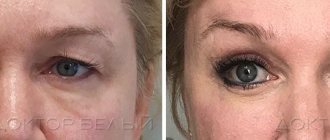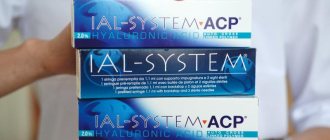Botulinum therapy is one of the safest methods in cosmetology. In addition, it helps to cope with complications after other aesthetic procedures and interventions. How, we will find out from an authoritative source.
Last December, the X National Congress “Plastic Surgery, Aesthetic Medicine and Cosmetology” took place, at which many relevant and interesting issues of aesthetic medicine and cosmetology were discussed. An entire session called “BOTO Summit” was dedicated to botulinum therapy. It is no secret that in the era of “self-improvement”, in addition to a significant increase in aesthetic procedures and techniques, the number of complications after their implementation is also increasing. Therefore, topics on how to cope with adverse events and their correction were of particular interest. excerpts from the report “Botulinum therapy in the treatment of complications after aesthetic procedures”, which was presented by Candidate of Medical Sciences, neurologist at the Central Institute of Botulinum Therapy and Current Neurology, member of the Ministry of Occupational Therapy Therapy Zagidat Narimanovna Konovalova
.
What can botulinum toxin do?
Everyone knows that injections of botulinum toxin (Botox, Dysport, Xeomin, Relatox and other drugs) allow you to straighten facial wrinkles, relax tension on the face, after which it looks younger and more attractive. Botulinum therapy for cosmetic purposes is one of the most popular and frequent procedures. However, botulinum toxin can also become an assistant for correcting complications after aesthetic interventions. “This drug is amazing in its capabilities,” says Zagidat Konovalova. “It can not only provide dosed muscle relaxation, but also has an analgesic effect, and also becomes relevant for the correction of complications. Their spectrum is very wide, from so-called adverse events to severe disorders that can appear on both the face and body. With timely detection and proper treatment, complications can be successfully corrected.”
What are the complications after aesthetic procedures:
- Allergy
- Infection
- Edema
- Hematoma
- Burn
- Thrombosis
- Necrosis
- Pigmentation
- Fibrosis
- Neurological disorders
What complications does botulinum toxin treat?
“One of the most common complications after various aesthetic procedures are neurological disorders (asymmetry, hyperkinesis, neuropathy, myospasms, myofascial pain syndrome), notes Zagidat Konovalova. — They can occur both after surgical and non-surgical procedures, for example, the introduction of fillers, thread implantation, and hardware. Be temporary or permanent. In this case, symptoms may be delayed (that is, not appear immediately), for example, as a result of migration of the drug, tearing off of the thread, and so on.
Plastic surgery is always a violation of tissue integrity, be it blepharoplasty, circular facial plastic surgery, abdominoplasty, mammoplasty, and so on. Here, too, doctors most often encounter neuropathy (a symptom complex consisting of motor, sensory, and autonomic manifestations) as a result of a violation of the integrity of the nerve due to trauma with instruments, compression (squeezing) due to edema, hematoma, exposure to the drug, and ischemia.”
Bags under the eyes: causes and methods of treatment
Outwardly, not only wrinkles and jowls age, but also the so-called bags under the eyes. They are also called zygomatic hernias or sufs. Hernias are protrusions of tissue. Paint bags are formed from subcutaneous fatty tissue of the skin in the cheekbone area. They are often confused with swelling on the face or bags under the eyes. And in appearance they look like them. The zygomatic hernia is located below the eye, on the nasozygomatic groove. Not only do paint bags make you look older, but they also distort other facial features. They give an overall sickly appearance. Thus, the fatty tissue of sufs leads to the formation of wrinkles and creases in the lower part of the face, making it heavier. They do not go away on their own; in such cases, professional help is needed. Let's look at ways to treat bags under the eyes.
Causes of zygomatic hernias
Painting bags are most often just an individual anatomical feature of the patient.
However, they can also form when:
- Diseases of the thyroid gland, kidneys or liver,
- Skin burns from ultraviolet radiation,
- Sudden changes in weight,
- Disturbed sleep and wakefulness patterns,
- Tendency to edema,
- Loss of skin elasticity (age-related changes, skin characteristics, long-term illness, etc.).
Even if the cause of the sufs is eliminated, they may not go away on their own. To do this, you will need to consult a cosmetologist.
Treatment for bags under the eyes
In our Cosmetology and Massage Center, we offer the two most effective methods of getting rid of zygomatic hernias - vector lifting with Radiesse and correction of the middle third of the face. Both methods are similar in effectiveness to plastic surgery, but do not injure tissue as much and require a shorter rehabilitation period.
Vector lifting with Radiesse. Under local anesthesia, filler is injected under the skin. The drug contains calcium hydroxyapatite. This substance actively affects tissues, stimulating them to produce collagen, which is so necessary for the skin. Collagen fibers are responsible for the elasticity of the skin. She straightens out, reducing the zygomatic hernia. The effect is noticeable 1 hour after the procedure. The result is permanent for 1-3 years with proper self-care and compliance with all doctor’s recommendations.
Correction of the middle third of the face. We are talking about contouring using preparations based on hyaluronic acid. This substance is so loved by cosmetologists because it is able to attract water molecules. The dermis is naturally moisturized from the inside, using the resources of the body itself. Volume is restored to the tissues in the cheekbone area, as a result of which the paint bag is filled and the skin is evened out. Correction of the middle third of the face models the entire oval by visually lifting the cheekbones and cheeks. The nasolabial fold is also camouflaged, providing a rejuvenating effect.
How the patient may feel during complications
Neurological complications most often occur due to damage to the facial or trigeminal nerves. With non-surgical procedures, the patient may notice the fact of such a violation during the process, which is manifested by sharp pain. The facial nerve is responsible for the motor activity of the facial muscles. When it is damaged, various motor function disorders can be observed, for example, asymmetry, hyperkinesis, etc.
“Patients also often complain of impaired sensitivity after aesthetic manipulations,” notes Zagidat Konovalova. - This can manifest as both hypersensitivity and numbness. And also the sensation of “crawling flies”, “facial hair”, tingling, burning, pain. Such disorders often occur due to trauma to the branches of the trigeminal nerve and require a visit to the clinic to a neurologist, a specialist in facial neurology.”
Red spots under the eyes (around the eyes)
Our skin is one of the first to react to any negative changes in the body. The more sensitive the skin, the faster and brighter the signs of any disease appear on it. The thinnest layer of skin is located in the area around the eyes. As a rule, the skin in this area is uniform in color, one tone lighter or darker than the base color of the facial skin. But sometimes red spots appear under or around the eyes, which can signal a number of diseases of the visual organs or the entire body as a whole.
Causes of red spots under the eyes
Various factors can cause the appearance of red spots around the eyes, including:
- Stress, lack of sleep and nervous tension. When the daily routine is normalized and the emotional state is restored, the redness disappears
- Dermatological problems. For example, with eczema and dermatitis, the skin around the eyes not only turns red, but also flakes and may also become crusty.
- Kidney diseases - stones, kidney failure and other pathologies make themselves felt by the appearance of bags, swelling, as well as redness or darkening under the eyes
- Inflammatory processes - abscesses and phlegmon (purulent inflammation). In such cases, redness is accompanied by increased body temperature.
- An allergic reaction in which in addition to redness there is also itching
- Vitamin deficiency and unhealthy lifestyle: lack of exercise, lack of air, poor diet and bad habits often contribute to the deterioration of skin condition
- Congenital skin abnormalities.
Do not forget that only a specialized specialist can establish the true cause of the disease and help get rid of unpleasant symptoms.
Treatment methods for complications
“To treat the motor functions of facial muscles with botulinum toxin, they first determine which muscles are damaged, which part of the face is impaired, and perform a series of injections into similar muscles on the opposite side of the face,” continues Zagidat Konovalova. “In this way, an aesthetic effect is achieved and the motor activity of the affected muscle is stimulated. The result can be observed within 10-14 days after injections.
If there are sensory disturbances, then in such cases it may be recommended to treat with botulinum neuroprotein subcutaneously on both sides so as not to provoke asymmetry. Also, sometimes two types of disorders are observed at once, which lead to both problems with sensitivity and motor pathologies, and therefore require the use of the two described methods.”
The main thing is timeliness
“Basically, disorders of the nerve branches occur due to the anatomical features or the techniques used,” concludes Zagidat Konovalova. “Naturally, patients faced with such a problem are extremely anxious. They are very concerned about whether their condition will return to normal and how long the recovery will take. Therefore, you should immediately tell your doctor about all the nuances and sensations that appear both during the procedures and after them. And it is very important for a specialist to begin intensive treatment, including botulinum therapy, immediately after identifying the pathology.”
Etiology and pathogenesis of furrows
The famous dermatologist Albert Kligman compared the evolution of wrinkles with the state of leather gloves: “New products are always smooth, but gradually creases appear in places of bending and pressure, which progress over time.” This analogy can be projected onto a person - wrinkles on the face appear in places of increased activity of facial muscles and then only get worse. The primary factor in their appearance is considered mechanical. This is confirmed by the absence of wrinkles, for example, on the outer side of the forearm, although the skin here often shows pronounced signs of photoaging.
But facial activity alone is not enough - for the appearance of deep furrows, nasolacrimal and others, other components are needed. One of them is ultraviolet radiation . It causes photoaging of the skin, resulting in increased activity of matrix metalloproteinases, which begin to actively destroy the extracellular matrix. In addition, the structure of elastin fibers changes, excessive production of glycosaminoglycans is observed, and the density of the microfibrillar network in the area of the dermal-epidermal junction and in the dermis decreases. This leads to a qualitative change in the structure and function of the skin, exacerbating wrinkles that appeared due to mechanical pressure.
A decisive role in the formation of deep grooves on the face is played by changes in the bones of the facial skeleton and the state of the superficial muscular aponeurotic system (Superficial muscular aponeurotic system, SMAS). SMAS is a special muscle structure whose free ends are attached to the skin using cords. Gradually, the strands degrade, and this happens at different rates - as a result, the tension of different parts of the face changes, they begin to sag, and wrinkles and deep furrows form on the face.
Gravity affects the appearance of deep tear troughs, causing sagging skin and increasing the appearance of wrinkles. Smoking significantly aggravates the condition of the skin, increasing the number and depth of wrinkles ( Fig. 1 ). Losing teeth plays an important role not only in changing the appearance of the face, but also in the appearance of deep wrinkles. For example, the loss of teeth on the lateral (side) side of the jaw leads to a narrowing of the face and hollowing of the cheeks, which changes the tension of the skin and leads to the formation of furrows.
A certain role in the appearance of deep wrinkles on the face is played by genetic predisposition (including race and skin phototype), general condition of the body (illness, chronic stress, hormonal levels, menopause), nutrition and lifestyle (including bad habits), place of residence (pollution air, number of sunny days per year), etc.
In vivo experiments noted an interesting feature of deep wrinkles: they can protect the skin inside the fold from the negative influence of external factors (for example, ultraviolet radiation). Since almost no sunlight penetrates into the deep fold, elastosis does not progress, and the condition of the skin in this area does not deteriorate as significantly as around the wrinkle.
Rice. 1. Skin of an 80-year-old non-smoker ( left ) and a 78-year-old smoker ( right ) (Osman O., Elbashir R., Abbass E., Kendrick I., et al. Automated Assessment of Facial Wrinkling: a case study on the effect of smoking. 2017)
Diagnosis and treatment of xanthelasma
Diagnosing xanthelasma does not require much effort. It is difficult to confuse a neoplasm with another pathology. Therefore, a qualified ophthalmologist only needs a visual examination to make the correct diagnosis. Nevertheless, the doctor will prescribe a biochemical blood test, a lipid profile, and also conduct differential diagnostics to exclude the malignant nature of the tumor or (in the case of single plaques) blockage of the sweat glands.
Today, there are several ways to get rid of xanthelasma.
- Laser treatment. The advantage of this method is the high precision of tumor removal with minimal invasiveness, the absence of scars, and the shortest recovery time.
- Electrocoagulation. The process of destroying plaques by exposing them to high-frequency current. The healing period can take up to two weeks, during which time it is necessary to provide adequate eyelid care with the use of medications.
- Cryocoagulation. Liquid nitrogen literally freezes fat deposits, destroying its structure and stopping cell growth.
However, these highly effective xanthelasma removal methods are applicable in cases where the size of the affected area does not exceed 4–5 mm. Otherwise, surgical removal of the tumor will be required.
The operation is performed under local anesthesia and requires cosmetic stitches, which are removed after 7–10 days. When completely healed, the scars are completely invisible. During the recovery period, it is necessary to protect your eyes from the sun and refrain from visiting the solarium. Ultraviolet radiation has an adverse effect, so pigmented scars may remain at the site of the sutures. For this reason, xanthelasma removal is usually carried out in the autumn-winter period, when there is no active bright sun.
Sometimes xanthelasma can recur. Although not often, the expert notes, it does happen. Moreover, new formations always affect new areas of the eyelids. The problem is that removing xanthelasma does not affect the underlying causes of its appearance. That is, those metabolic disorders in the body that provoked the emergence and growth of a benign tumor.
Causes of xanthelasma and risk groups
Xanthelasma is a benign formation that affects the skin of the upper and lower eyelids of both eyes.
Xanthelasma initially manifests itself as single plaques. If there are a large number of them, plaques can merge into extensive yellow formations of varying degrees of intensity - xanthoma - and significantly worsen a person’s appearance. Apart from being visually unattractive, xanthelasma does not manifest itself in any way. There is no pain, no itching, no peeling, or any other unpleasant sensations. Considering the main cause of xanthelasma, risk groups are identified among people susceptible to xanthelasma:
- people over 45–50 years old;
- women (xanthelasma more often spoils the appearance of the fair sex, although similar cases are also recorded in men);
- people with chronic diseases, one way or another associated with impaired fat metabolism and metabolic dysfunction: diabetes, obesity, arterial hypertension, diseases of the thyroid and pancreas, liver, etc.
